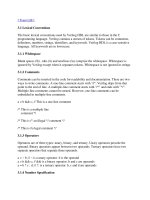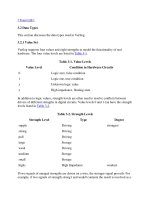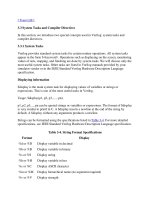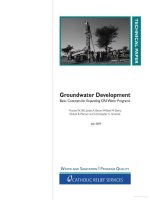Basic Concepts
Bạn đang xem bản rút gọn của tài liệu. Xem và tải ngay bản đầy đủ của tài liệu tại đây (3.05 MB, 21 trang )
CHAPTER
1
Basic Concepts
Introduction
Probability can be defined as the mathematics of chance. Most people are
familiar with some aspects of probability by observing or playing gambling
games such as lotteries, slot machines, black jack, or roulette. However,
probability theory is used in many other areas such as business, insurance,
weather forecasting, and in everyday life.
In this chapter, you will learn about the basic concepts of probability using
various devices such as coins, cards, and dice. These devices are not used as
examples in order to make you an astute gambler, but they are used because
they will help you understand the concepts of probability.
1
Copyright © 2005 by The McGraw-Hill Companies, Inc. Click here for terms of use.
Probability Experiments
Chance processes, such as flipping a coin, rolling a die (singular for dice), or
drawing a card at random from a well-shuffled deck are called probability
experiments.Aprobability experiment is a chance process that leads to well-
defined outcomes or results. For example, tossing a coin can be considered
a probability experiment since there are two well-defined outcomes—heads
and tails.
An outcome of a probability experiment is the result of a single trial of
a probability experiment. A trial means flipping a coin once, or drawing a
single card from a deck. A trial could also mean rolling two dice at once,
tossing three coins at once, or drawing five cards from a deck at once.
A single trial of a probability experiment means to perform the experiment
one time.
The set of all outcomes of a probability experiment is called a sample
space. Some sample spaces for various probability experiments are shown
here.
Experiment Sample Space
Toss one coin H, T*
Roll a die 1, 2, 3, 4, 5, 6
Toss two coins HH, HT, TH, TT
*H = heads; T = tails.
Notice that when two coins are tossed, there are four outcomes, not three.
Consider tossing a nickel and a dime at the same time. Both coins could fall
heads up. Both coins could fall tails up. The nickel could fall heads up and
the dime could fall tails up, or the nickel could fall tails up and the dime
could fall heads up. The situation is the same even if the coins are
indistinguishable.
It should be mentioned that each outcome of a probability experiment
occurs at random. This means you cannot predict with certainty which
outcome will occur when the experiment is conducted. Also, each outcome
of the experiment is equally likely unless otherwise stated. That means that
each outcome has the same probability of occurring.
When finding probabilities, it is often necessary to consider several
outcomes of the experiment. For example, when a single die is rolled, you
may want to consider obtaining an even number; that is, a two, four, or six.
This is called an event. An event then usually consists of one or more
CHAPTER 1 Basic Concepts
2
outcomes of the sample space. (Note: It is sometimes necessary to consider
an event which has no outcomes. This will be explained later.)
An event with one outcome is called a simple event. For example, a die is
rolled and the event of getting a four is a simple event since there is only one
way to get a four. When an event consists of two or more outcomes, it is
called a compound event. For example, if a die is rolled and the event is getting
an odd number, the event is a compound event since there are three ways to
get an odd number, namely, 1, 3, or 5.
Simple and compound events should not be confused with the number of
times the experiment is repeated. For example, if two coins are tossed, the
event of getting two heads is a simple event since there is only one way to get
two heads, whereas the event of getting a head and a tail in either order is
a compound event since it consists of two outcomes, namely head, tail and
tail, head.
EXAMPLE: A single die is rolled. List the outcomes in each event:
a. Getting an odd number
b. Getting a number greater than four
c. Getting less than one
SOLUTION:
a. The event contains the outcomes 1, 3, and 5.
b. The event contains the outcomes 5 and 6.
c. When you roll a die, you cannot get a number less than one; hence,
the event contains no outcomes.
Classical Probability
Sample spaces are used in classical probability to determine the numerical
probability that an event will occur. The formula for determining the
probability of an event E is
PðEÞ¼
number of outcomes contained in the event E
total number of outcomes in the sample space
CHAPTER 1 Basic Concepts
3
EXAMPLE: Two coins are tossed; find the probability that both coins land
heads up.
SOLUTION:
The sample space for tossing two coins is HH, HT, TH, and TT. Since there
are 4 events in the sample space, and only one way to get two heads (HH),
the answer is
PðHHÞ¼
1
4
EXAMPLE: A die is tossed; find the probability of each event:
a. Getting a two
b. Getting an even number
c. Getting a number less than 5
SOLUTION:
The sample space is 1, 2, 3, 4, 5, 6, so there are six outcomes in the sample
space.
a. P(2) ¼
1
6
, since there is only one way to obtain a 2.
b. P(even number) ¼
3
6
¼
1
2
, since there are three ways to get an odd
number, 1, 3, or 5.
c. P(number less than 5Þ¼
4
6
¼
2
3
, since there are four numbers in the
sample space less than 5.
EXAMPLE: A dish contains 8 red jellybeans, 5 yellow jellybeans, 3 black
jellybeans, and 4 pink jellybeans. If a jellybean is selected at random, find the
probability that it is
a. A red jellybean
b. A black or pink jellybean
c. Not yellow
d. An orange jellybean
CHAPTER 1 Basic Concepts
4
SOLUTION:
There are 8 + 5 + 3 + 4 = 20 outcomes in the sample space.
a. PðredÞ¼
8
20
¼
2
5
b. Pðblack or pinkÞ¼
3 þ 4
20
¼
7
20
c. P(not yellow) = P(red or black or pink) ¼
8 þ 3 þ 4
20
¼
15
20
¼
3
4
d. P(orange)=
0
20
¼ 0, since there are no orange jellybeans.
Probabilities can be expressed as reduced fractions, decimals, or percents.
For example, if a coin is tossed, the probability of getting heads up is
1
2
or
0.5 or 50%. (Note: Some mathematicians feel that probabilities should
be expressed only as fractions or decimals. However, probabilities are often
given as percents in everyday life. For example, one often hears, ‘‘There is a
50% chance that it will rain tomorrow.’’)
Probability problems use a certain language. For example, suppose a die
is tossed. An event that is specified as ‘‘getting at least a 3’’ means getting a
3, 4, 5, or 6. An event that is specified as ‘‘getting at most a 3’’ means getting
a1,2,or3.
Probability Rules
There are certain rules that apply to classical probability theory. They are
presented next.
Rule 1: The probability of any event will always be a number from zero to one.
This can be denoted mathematically as 0 P(E) 1. What this means is that
all answers to probability problems will be numbers ranging from zero to
one. Probabilities cannot be negative nor can they be greater than one.
Also, when the probability of an event is close to zero, the occurrence of
the event is relatively unlikely. For example, if the chances that you will win a
certain lottery are 0.00l or one in one thousand, you probably won’t win,
unless of course, you are very ‘‘lucky.’’ When the probability of an event is
0.5 or
1
2
, there is a 50–50 chance that the event will happen—the same
CHAPTER 1 Basic Concepts
5
probability of the two outcomes when flipping a coin. When the probability
of an event is close to one, the event is almost sure to occur. For example,
if the chance of it snowing tomorrow is 90%, more than likely, you’ll see
some snow. See Figure 1-1.
Rule 2: When an event cannot occur, the probability will be zero.
EXAMPLE: A die is rolled; find the probability of getting a 7.
SOLUTION:
Since the sample space is 1, 2, 3, 4, 5, and 6, and there is no way to get a 7,
P(7) ¼ 0. The event in this case has no outcomes when the sample space is
considered.
Rule 3: When an event is certain to occur, the probability is 1.
EXAMPLE: A die is rolled; find the probability of getting a number less
than 7.
SOLUTION:
Since all outcomes in the sample space are less than 7, the probability is
6
6
¼1.
Rule 4: The sum of the probabilities of all of the outcomes in the sample space
is 1.
Referring to the sample space for tossing two coins (HH, HT, TH, TT), each
outcome has a probability of
1
4
and the sum of the probabilities of all of the
outcomes is
1
4
þ
1
4
þ
1
4
þ
1
4
¼
4
4
¼ 1:
Fig. 1-1.
CHAPTER 1 Basic Concepts
6
Rule 5: The probability that an event will not occur is equal to 1 minus the
probability that the event will occur.
For example, when a die is rolled, the sample space is 1, 2, 3, 4, 5, 6.
Now consider the event E of getting a number less than 3. This event
consists of the outcomes 1 and 2. The probability of event E is
PðEÞ¼
2
6
¼
1
3
. The outcomes in which E will not occur are 3, 4, 5, and 6, so
the probability that event E will not occur is
4
6
¼
2
3
. The answer can also
be found by substracting from 1, the probability that event E will occur.
That is, 1 À
1
3
¼
2
3
.
If an event E consists of certain outcomes, then event
E (E bar) is called the
complement of event E and consists of the outcomes in the sample space
which are not outcomes of event E. In the previous situation, the outcomes in
E are 1 and 2. Therefore, the outcomes in
E are 3, 4, 5, and 6. Now rule five
can be stated mathematically as
Pð
EÞ¼1 À PðEÞ:
EXAMPLE: If the chance of rain is 0.60 (60%), find the probability that it
won’t rain.
SOLUTION:
Since P(E) = 0.60 and Pð
EÞ¼1 À PðEÞ, the probability that it won’t rain is
1 À 0.60 = 0.40 or 40%. Hence the probability that it won’t rain is 40%.
PRACTICE
1. A box contains a $1 bill, a $2 bill, a $5 bill, a $10 bill, and a $20 bill.
A person selects a bill at random. Find each probability:
a. The bill selected is a $10 bill.
b. The denomination of the bill selected is more than $2.
c. The bill selected is a $50 bill.
d. The bill selected is of an odd denomination.
e. The denomination of the bill is divisible by 5.
CHAPTER 1 Basic Concepts
7
2. A single die is rolled. Find each probability:
a. The number shown on the face is a 2.
b. The number shown on the face is greater than 2.
c. The number shown on the face is less than 1.
d. The number shown on the face is odd.
3. A spinner for a child’s game has the numbers 1 through 9 evenly
spaced. If a child spins, find each probability:
a. The number is divisible by 3.
b. The number is greater than 7.
c. The number is an even number.
4. Two coins are tossed. Find each probability:
a. Getting two tails.
b. Getting at least one head.
c. Getting two heads.
5. The cards A˘,2
^
,3¨,4˘,5¯, and 6¨ are shuffled and dealt face down
on a table. (Hearts and diamonds are red, and clubs and spades are
black.) If a person selects one card at random, find the probability that
the card is
a. The 4˘.
b. A red card.
c. A club.
6. A ball is selected at random from a bag containing a red ball, a
blue ball, a green ball, and a white ball. Find the probability
that the ball is
a. A blue ball.
b. A red or a blue ball.
c. A pink ball.
7. A letter is randomly selected from the word ‘‘computer.’’ Find the
probability that the letter is
a. A ‘‘t’’.
b. An ‘‘o’’ or an ‘‘m’’.
c. An ‘‘x’’.
d. A vowel.
CHAPTER 1 Basic Concepts
8









